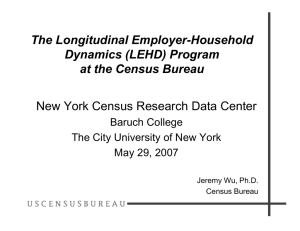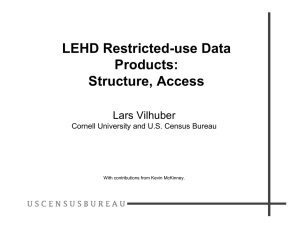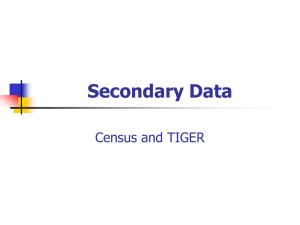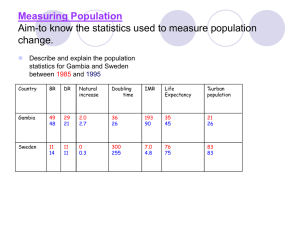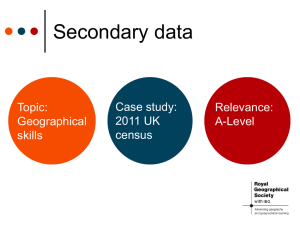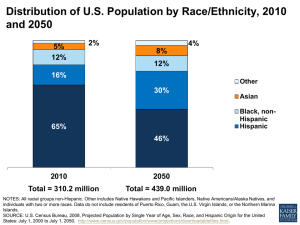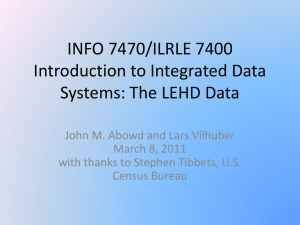Local Employment Dynamics Training
advertisement
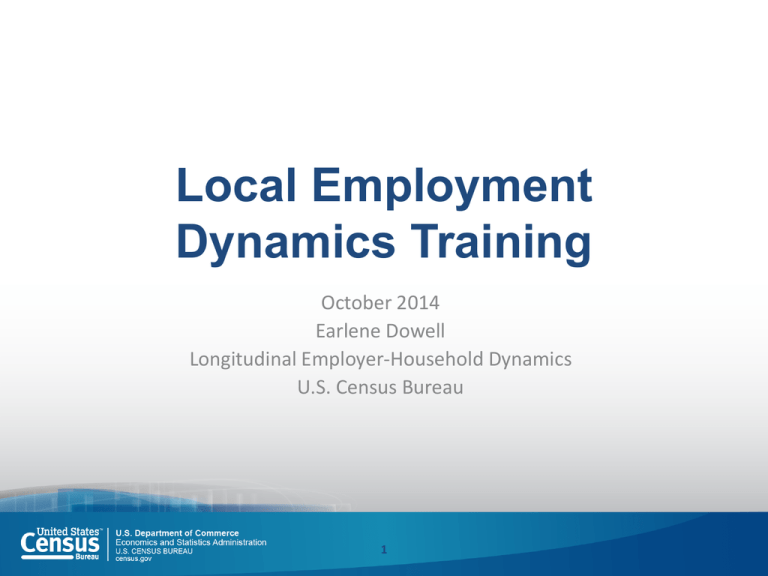
Local Employment Dynamics Training October 2014 Earlene Dowell Longitudinal Employer-Household Dynamics U.S. Census Bureau 1 LED Training Goals This training will include several topics: Basic overview of LEHD program and the QWI and LODES dataset Hands-on demonstrations of new data tools for accessing the QWI: LED Extraction Tool and QWI Explorer Overview and demonstration of OnTheMap and the new OnTheMap for Emergency Management Application 2 LED Vs. LEHD LED: Local Employment Dynamics Partnership between Census and States States voluntarily submit quarterly data (UI Wage Records and QCEW reports) Census processes and develops public use products LEHD: Longitudinal Employer-Household Dynamics Public data products Quarterly Workforce Indicators (QWI) - QWI Explorer and LED Extraction Tool LEHD Origin Destination Employee Statistics (LODES) – OnTheMap and OnTheMap for Emergency Management More in pipeline 3 Reference Materials QWI 101 Introduction to development and use of QWI Excellent reference for new users http://lehd.ces.census.gov/doc/QWI_101.pdf “The LEHD Infrastructure Files and the Creation of the Quarterly Workforce Indicators” Detailed methodology, intended for advanced users http://lehd.ces.census.gov/doc/technical_paper/tp-2006-01.pdf 4 Where to Find LED Data Census Website Longitudinal Employer-Household Dynamics Program http://lehd.ces.census.gov/data/ Variety of tools for accessing the data 5 Primary Unit of Analysis: Job Definition: A “job” is an association of specific individual with specific employer and location in a given year/quarter An individual may have multiple jobs within a quarter The “primary job” (job with greatest earnings) is not defined separately in QWI, though it does appear in OnTheMap The job is the basic unit of analysis within the LEHD Infrastructure In contrast, most other surveys and censuses are either household-based (ACS, CPS, Decennial Census) or employer-based (QCEW, Current Employment Statistics, etc) Advantage of job-based frame – can produce tabulations by both worker and firm characteristics 6 Core Data Input: UI Earnings Records UI = Unemployment Insurance Record of individual earnings for covered jobs These are the wage records, not UI claims data Collected for operation of state UI program UI benefits are based on historical earnings Includes: Total quarterly earnings for each job Firm identified by State UI Account number (SEIN) Worker identified by Protected Identification Key (PIK) Census identifier based on SSN 7 Job Coverage in UI Earnings Data Most private sector jobs covered For-profit and not-for-profit classified together (as per QCEW standard) State and local government also in system, though some reporting inconsistencies Federal data not available in QWI Data based on Office of Personnel Management (OPM) under development for QWI (have been incorporated into LODES) Self-employed not available Data derived from tax records under development Massachusetts data not available yet 8 Additional Data Inputs UI wage records are linked to a variety of other data sources Sources of establishment information: Quarterly Census of Employment and Wages (QCEW) Business Dynamics Statistics (BDS) Sources of demographic information: Decennial Census Federal Tax Records Social Security Administration Records Other census and administrative records This additional information enables tabulations by detailed worker and firm characteristics 9 LEHD Processing: Merging Data Quarterly Census of Employment and Wages (QCEW) Employer and Establishment (Single/Multi-unit) UI Account Number (SEIN) Unemployment Insurance Earnings Records Employer-Worker (most states) OR Establishment-Worker (Minnesota only) Geography Industry Ownership Earnings Job history PIK (encoded SSN) Federal EIN Census, Surveys, Other Administrative Records Business Dynamics Statistics (BDS) Firm age and size 10 Demographics Place of Residence QWI The QWI provide 32 measures of employment counts, employment flows, and earnings By linking to a variety of data sources, the QWI can be tabulated by detailed geography, firm characteristics and worker demographics The LEHD program has developed multiple webbased tools for accessing the QWI. These will be demonstrated in this session. Contact us: ces.qwi.feedback@census.gov 11 QWI Measures The QWI public use data includes 32 measures Employment Counts of jobs (Individual) Hiring and Separation counts and rates (Individual) Job Creation and Destruction (Firm/Establishment) Earnings Average earnings for selected job histories Total earnings Public use files and web-based applications are organized by state (national QWI are currently being developed) 12 Live Demo WWW.CENSUS.GOV 13 LEHD www.lehd.ces.census.gov 14 LED Extraction Tool 15 Firm Characteristics 16 Worker Characteristics 17 Firm Indicators 18 Quarters 19 Summary Export 20 CSV 21 QWI Explorer 22 NAICS 4-Digit Industries 23 Monthly Earnings 24 NAICS - 3364 25 LODES Data The basic structure of released data are the following file types: Origin-Destination (OD) Residence Area Characteristics (RAC) Workplace Area Characteristics (WAC) 26 OD, RAC, and WAC OD Connects a home block with a work block. Gives one count of jobs for each home-work block pair and for each combination of year, job type, and segment variables. RAC/WAC Provides totals on residence/workplace side only. Gives one total for each worker/job characteristic for each combination of year, job type, and segment variables. 27 Getting Started http://onthemap.ces.census.gov/ 28 Perform Analysis 29 Analysis Setting 30 Home Area Profile Analysis 31 Home Area Comparison Analysis by Census Tracts 32 Distance/Direction Analysis Home to Work 33 Work Destination Analysis 34 Inflow/Outflow 35 Paired Area Analysis 36 Help and Documentation 37 Data Tab 38 Text Only 39 OnTheMap for Emergency Management 40 DR-4176 41 FEMA 42 Advanced OnTheMap 43 Results of 2011 Tuscaloosa/Birmingham Tornado 44 Questions? Contact Information Earlene Dowell CES.Local.Employment.Dynamics@census.gov Join the List Serve lehd-onthemap@lists.census.gov lehd-general@lists.census.gov 45
